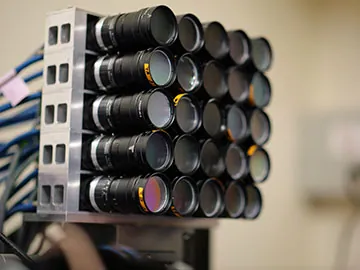
Revolutionary 25-Camera Microscope Set to Transform Biological Imaging
2025-08-22
Author: Yu
In a groundbreaking development, researchers in the U.S. have unveiled a high-speed microscope equipped with a remarkable 25-camera array that captures detailed 3D images of tiny, moving organisms in real-time. This innovative technology, tested for tracking dynamic particles and microorganisms, promises to revolutionize biomedical imaging.
The Challenge of Imaging Life in 3D
For biologists, understanding the intricate dance of life often requires studying specimens in three dimensions. Traditional optical microscopes, however, typically produce 2D images, necessitating prolonged processes to stitch these images into a coherent 3D view. This sequential imaging is painfully slow, incapable of accurately capturing molecular movements that occur within milliseconds. While faster techniques exist, such as light-sheet fluorescence microscopy, they often compromise either spatial detail or temporal resolution.
Innovative Camera Array Overcomes Limitations
The new microscope, created by a collaborative team from the University of California Santa Cruz and other institutions, features a unique 25-plane multifocus grating. This setup transforms a single image beam from a conventional microscope into a vibrant 5 × 5 array, pulling images from various diffractive orders for enhanced clarity. To tackle chromatic dispersion—an issue that obscures color accuracy—the majority of the cameras in the array have been outfitted with advanced chromatic correction optics.
A Leap in Affordable Technology
As noted by lead researchers Sara Abrahamsson and Eduardo Hirata Miyasaki, harnessing an array of 25 cameras would have been prohibitively expensive and complex just twenty years ago. However, thanks to advancements in high-speed, sensitive, and affordable machine vision cameras, this ambitious project has become a reality today. The design is also adaptable, opening the door to even larger arrays, allowing for unprecedented imaging depth for larger biological specimens.
Implications for the Future
This cutting-edge technology is not just a triumph of engineering; it holds immense potential for fields ranging from cellular biology to pharmacology, enabling scientists to observe interactions at the cellular level with unprecedented clarity and speed. With this versatile microscope, the mysteries of life could soon be unveiled faster than ever before!


 Brasil (PT)
Brasil (PT)
 Canada (EN)
Canada (EN)
 Chile (ES)
Chile (ES)
 Česko (CS)
Česko (CS)
 대한민국 (KO)
대한민국 (KO)
 España (ES)
España (ES)
 France (FR)
France (FR)
 Hong Kong (EN)
Hong Kong (EN)
 Italia (IT)
Italia (IT)
 日本 (JA)
日本 (JA)
 Magyarország (HU)
Magyarország (HU)
 Norge (NO)
Norge (NO)
 Polska (PL)
Polska (PL)
 Schweiz (DE)
Schweiz (DE)
 Singapore (EN)
Singapore (EN)
 Sverige (SV)
Sverige (SV)
 Suomi (FI)
Suomi (FI)
 Türkiye (TR)
Türkiye (TR)
 الإمارات العربية المتحدة (AR)
الإمارات العربية المتحدة (AR)